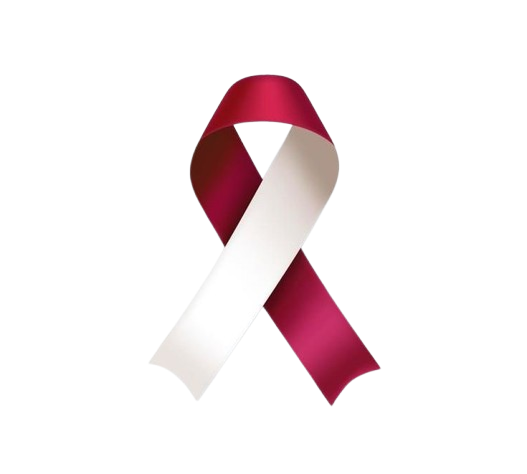About Cancer
What is Cancer?
- Cells are the basic units of life, and all living beings are made up of these cells.
- Cells organize into tissues that perform specific functions, and these tissues form organs like the skin, liver, lungs, and kidneys.
- Normally, cells divide, multiply, and grow in a controlled manner.
- When the control mechanism fails, cells begin to multiply uncontrollably, leading to abnormal growth.
- Cancer can arise in any organ of the body, such as the lungs, breast, liver, kidney, brain, etc.
- Cancer is not just a single disease but a group of many different diseases.
How cancer does develop?
- When under the influence of certain internal or external factors, cells lose control over normal process of multiplication and start multiplying in an uncontrolled manner, formation of mass of cells forms which is called tumour.
- These fast-multiplying cells are called cancer cells.
Common Cancer

Breast Cancer
Worldwide the incidence of breast cancer is the most common of all cancer and leading cause of death due to cancer. In India approximately 4% women develop breast cancer and which is more in urban area with 4.5% incidence and in rural area it is approximately 1.6%. The average high risk age group in India is 45 to 48 years. Many factors attribute for the occurrence of breast cancer in women. The risk factors includes
- Age
- Gender
- History of breast cancer in family
- Menstrual history
- Hormonal changes
- Age of menarche
- Age of Menopause
Breast Awareness
Breast awareness is knowing about your breast. It is a process of getting to know the appearance of your own breast and to know what is normal for you in different times. By this you will be familiar with the breast tissue. If you know how the normal breast is then you can easily be aware of any changes which may abnormal.
Normal Breast
Before menopause, normal breast feels different at different times of the month. The milk producing tissue is breast become active in the days before period starts. In some women at these times breast feel tender and lumpy especially near armpits. After menopause the activity in milk producing tissue stops so the breasts feel soft, less firm.
Breast Self-Examination (BSE)
Breast self-examination is the easiest thing to do and can be done at home. Women can do BSE anytime like in the bath, shower or in front of mirror. While BSE changes one must lookout for
- Appearance: Any change in the outline or shape of breast, especially those caused by arm movements or by lifting the breasts. Lookout carefully for any dimpling or puckering of the skin.
- Pain: Any pain or discomfort in any breast which is not normal and may persist.
- Lumps or Node: Lookout for lumps, thickening or bumpy areas on breast or armpit which may be different from the other breast.
- Changes in Nipples: Any kind of nipple discharge, bleeding, moist reddish area which is abnormal. Skin rash on or around the nipple.
There may be many reasons for any such changes which may or may not leads to cancer but every such change on breast should be discussed with the doctor and checked thoroughly.
Screening
Women aged 50 or above, it is strongly recommended that breast screening should be done once in three years. Especially women having first degree relative have breast cancer then the risks of breast cancer are doubled. By doing BSE women can be always watchful and once in three years one can go for mammography which can detect any changes. Remember breast cancer is one of those cancers which are curable if detected and reported earlier to the doctor.
Treatment
Treatment depends on accessing the disease condition, type of breast cancer based on molecular profiling for which investigations are done. After proper investigations the staging of the disease is ascertained and according to the evidence-based guidelines the treatment is done. Treatment may include single modality or multimodality approach from surgery, chemotherapy or radiotherapy. Different types of treatment options are available today in medical oncology like, chemotherapy, hormonal therapy, targeted therapy, immunotherapy.

Cervical Cancer
Cervix starts from lower end of uterus and ends in the upper end of vagina. Cervical cancer is the cancer of cervix which is treatable. Cervix cancer is a slowly growing cancer, before cancer develops; the tissue of cervix undergoes changes, which may not be cancerous. But if untreated for long these may develop into cancerous.
Risk Factors
There are few risk factors which may cause cervix cancer.
- HPV (Human papilloma virus) infection is the most significant cause of cervix cancer.
- Early age first sexual intercourse (under 15 years of age).
- History of breast cancer in family
- Having many sexual partners.
General Symptoms
- Unusual discharge from vagina.
- Pain and bleeding during or after sexual intercourse.
- Other than normal bleeding during periods, blood spots.
Screening of Cervical Cancer
A pap test is done normally to detect cervical cancer or the disease condition that may develop into cervix cancer later.
Treatment
Treatment depends on accessing the disease condition which depends on the reports of various investigations done. After proper investigations the staging of the disease is ascertained and according to the evidence-based guidelines the treatment is done. Treatment may include single modality or multimodality approach from surgery, chemotherapy, immunotherapy etc or radiotherapy.

Colorectal Cancer
Colorectal cancer if detected early can be controlled and cured. Early detection gives excellent treatment response. Colorectal cancer occurs in colon of large intestine and rectum. In our digestive tract colon is part of large intestine which absorbs nutrients and water from food and rectum is the lower end of in large intestine which holds the stool which later pass out through anus, the opening of rectum. In most of cases, colorectal cancer develops very slowly over the years which often begin with small benign polyps in sigmoid colon which later on develops into cancerous lesions. The extent of penetration of these cancerous growths into the tissue layers determines the stage of disease.
Risk Factors
Predisposing Factors of colorectal cancer are
- Age above 40 years old.
- Diet Low in Fiber and high in fat, protein and refined carbohydrates
- Obesity
- History of chronic constipation
- History of IBD, familial polyposis or colon polyps
- Family history of colon cancer
General Symptoms
- Occult Blood (blood in stool)
- Rectal bleeding
- Abdominal pain
- Often complaints of constipation, diarrhoea
- Narrowing of stool passing
- Pain and irritation while passing stool
- Fatigue
- Anorexia
- Tenesmus
- Palpable mass
Not necessary all these symptoms are of colorectal cancer, can be due to some other reasons also, but it is always better to immediately report to your doctor if such complaints seen.
Screening of Colorectal cancer
- For the screening colonoscopy is the best method which can detect any polyps or other growths in colon or rectum. Doctor examines the rectum and colon through a fine tube which is fitted with a light on the other end.
- FOB (Faecal Occult Blood Test) is the laboratory test that looks into the blood in stool for cancerous cells.
- DRE (Digital Rectal Examination) can also be done when physical examination is done.
Colonoscopy can be done once in 10 years for screening purpose. Prognosis Assessment If colorectal cancer is detected, then prognosis assessment is required for staging of the disease. For this purpose, additional investigations are required.
- CT Scan
- MRI Scan
- PET Scan
- Endorectal USG
- CEA Marker Detection
Which investigation methods are required is decided by the doctor depending about his assessment of the disease.
Treatment
Treatment depends on accessing the disease condition which depends on the reports of various investigations done. After proper investigations the staging of the disease is ascertained and according to the evidence-based guidelines the treatment is done. Treatment may include single modality or multimodality approach from surgery, chemotherapy, targeted therapy, immunotherapy or radiotherapy.

Gastric Cancer
Gastric cancer is the cancer of the stomach. Stomach is the J shaped organ and part of upper digestive tract. The actual digestion of food starts here. Stomach cancer develops slowly and less symptomatic or symptoms coincides with disease which people doesn’t take seriously, often detected late with poor prognosis.
Risk Factors
Risk Factors of Gastric cancer are
- H. Pylori infection of stomach. The inflammation of stomach caused by infection may lead to ulcers which may lead to precancerous changes.
- Pernicious anaemia
- Smoking
- Alcohol abuse
- Diet habit like food rich in fats, salts, red meat, chilies, smoked food etc. may be a risk for gastric cancer.
- Family history of gastric cancer.
- Stomach polyps
General Symptoms
- Heart burn
- Stomach pain
- Vomiting or nausea
- Loss of appetite
- Indigestion
- Unexplained weight loss
- Blood in stool
- Frequent bloating of meals
These symptoms normally are overlooked by people and end up taking remedies of their own. They never report such symptoms to doctor.
Diagnosis
Diagnosis endoscopy can be done. Endoscope is a thin tube with light and camera at one end. Doctor can see through the camera inside the stomach and look for lesions and polyps. Through various other investigation and blood test are done to get into the details of disease.
Treatment
Treatment depends on accessing the disease condition which depends on the reports of various investigations done. After proper investigations the staging of the disease is ascertained and according to the evidence-based guidelines the treatment is done. Treatment may include single modality or multimodality approach from surgery, chemotherapy or radiotherapy.

Head & Neck Cancer
Head & Neck Cancers are most common cancers seen in Indian men. The area in which they begin further identifies cancers of the head and neck – oral, salivary glands, Para nasal sinuses and nasal cavity, Pharynx, Larynx, Lymph nodes, Thyroid gland.
Risk Factors
85% of head and neck cancers are linked to tobacco use. People who use both tobacco and alcohol are at greater risk for developing these cancers than people who use either of them alone. HPV infection of oral epithelial layer also is a risk factor for head and neck cancer occurrence. Lesions and mouth ulcers not residing for long period may turn into cancerous lesions.
General Symptoms
Some of the symptoms are generally overlooked by many of us but such symptoms listed below should be reported to the doctor.
- White or red patch in mouth that doesn't fade away.
- Mouth ulcers and sore throat which persist for long.
- Voice change and hoarseness of voice.
- Persistence pain in neck, throat, nasal passage, ears.
- Infection and losing of teeth.
- Lesions on tongue.
- Lump or node in the neck region.
- Blood in sputum.
- Trismus
- Difficulty in swallowing.
Screening and Diagnosis
Screening can be done by thorough physical examination. For proper diagnosis along with physical examination, certain investigations are required like endoscopy, x rays of teeth, jaws, chest, barium swallow, CT scan, PET scan, MRI etc. After proper investigations the assessment of the disease is done.
Treatment
Treatment depends on accessing the disease condition which depends on the reports of various investigations done. After proper investigations the staging of the disease is ascertained and according to the evidence-based guidelines the treatment is done. Treatment may include single modality or multimodality approach from surgery, chemotherapy, targeted therapy, immunotherapy or radiotherapy.

Lung Cancer
Lungs are two large spongy organs shaped like a butterfly located in the chest region of the body. The inhaled air which contains oxygen is exchanged with carbon dioxide in lungs and this oxygen is finally reaches to all organs and tissues of the body through the circulatory system (blood and veins and arteries). The carbon dioxide is exhaled out. Lung cancer usually starts in the lining of the bronchi (the airways of lungs) or it also starts in respiratory tract including trachea or alveoli. It occurs in both women and men.
Risk Factors
Majority of the all-lung cancer cases are related to tobacco use. There are various rick factors for lung cancer which are enlisted below.
- Cigarette smoking remains the greatest risk for lung cancer. Cancer risk increases with the number of cigarettes smoked each day and number of years a person has smoked. Risk also greater if the individual had started smoking early in his life even if he quits smoking later on.
- Exposure to some of chemicals like asbestos, cement dust, quarry dust, dyes, arsenic, occupational exposure of radiation etc.
- Old age is one of the risk factors of lung cancer especially who have a smoking history.
- Heredity though not established but certain studies point out as one of the risk factors of lung cancer.
- People who are suffering Tuberculosis are also having the risk of lung cancer.
General Symptoms
Lung cancer may start as a silent disease with very common symptoms and in later part show a very poor prognosis.
- Persistent chest pain.
- Coughing up blood.
- Cough that doesn't get resolved and get more severe over time.
- Wheezing, dyspnoea (shortness of breath), change in voice.
- Fatigue
- Frequent lung infections.
- Loss of appetite.
- Unexplained loss of weight.
- Swelling of neck and face.
Screening and Diagnosis
Apart from physical examination doctor will ask for some additional investigations for the confirmation of diagnosis. These investigations may be
- Chest X ray used to look for any mass or spot on the lungs.
- Blood Test is done for changes in blood indicative of cancer.
- Sputum Examination is done under the microscope to confirm the diagnosis.
- Needle biopsy of the lungs is done for any malignancy in the lungs.
- Bronchoscopy is the examination of bronchi using a flexible tube, which helps to evaluate and diagnose lung cancer.
- CT scan show detail images of lungs which gives a correct perspective of the disease.
Treatment
Lung Cancer is differentiated based on the histology in non-small cell lung cancer and small cell lung cancer. Based on the molecular profiling of the disease and accessing the disease condition which depends on the reports of various investigations done the final line of treatment is decided. After proper investigations the staging of the disease is ascertained and according to the evidence-based guidelines the treatment is done. Treatment may include single modality or multimodality approach from surgery, chemotherapy, targeted therapy, immunotherapy or radiotherapy.

Ovarian Cancer
The cancer developed in ovaries is called ovarian cancer. Ovaries are the organs in women where the ovum (egg) is formed and later on it gets fertilized by sperm. Ovarian cancer is the most common cancer among female population in India and ovarian cancer is the 5th leading cause of cancer deaths among women. Ovarian cancer cells can break away from ovary and spread to other tissues as well.
Risk Factors
Some factors which increase the risk of developing ovarian cancer are
- Heredity may be one of the risk factors where women who have close relative like daughter, mother, sister with ovarian cancer have increased risk of the disease.
- Age is one of the important factors where women with over 55 years are more prone to ovarian cancer.
- Women who are never pregnant or with late pregnancy are at higher risk of developing ovarian cancer.
- Women who undergone hormonal treatment for substantial period of time are also at higher risk.
General Symptoms
Signs and symptoms of ovarian cancer are
- General abdominal discomfort like pain, indigestion, pressure, swelling, bloating, cramps.
- Nausea, frequent urination, constipation, diarrhoea.
- Unexplained weight loss or weight gain.
- Abnormal bleeding or discharge from vagina
Screenings
Ovarian cancer is hard to detect early. The chances of recovery are better if detected soon. Many times, women are asymptotic or just show mild symptoms until the disease is in an advanced stage. Some test may find useful for screening of ovarian cancer. Blood test for CA-125 and transvaginal Ultrasound may be quite useful in screening ovarian cancer.
Diagnosis
Apart from thorough physical and pelvic examination and medical history doctor may go for further investigations like biopsy, CA-125 assay, CT scan, X rays etc.
Treatment
Treatment depends on accessing the disease condition which depends on the reports of various investigations done. After proper investigations the staging of the disease is ascertained and according to the evidence-based guidelines the treatment is done. Treatment may include single modality or multimodality approach from surgery, chemotherapy, immunotherapy or radiotherapy.